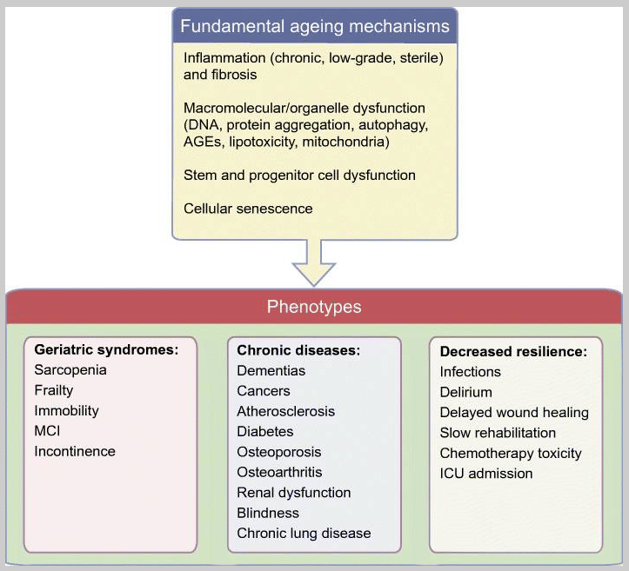
SENOLYTICS: DASATINIB & QUERCETIN

All of the cells in our bodies are continuously renewing themselves. Older cells are aging and dying; at the same time, new cells are being generated. Sometimes this process can go wrong, and some cells become damaged and remain. These damaged cells are called senescent cells and they can have a negative influence on the other nearby cells. This changes how the neighboring cells handle inflammation, sugars or proteins, and can cause metabolic problems as well as lead to multiple age-related chronic diseases.
What are Senolytics?
Senolytics are a class of drugs, supplements or peptides that can help eliminate senescent cells. They do this by disabling the mechanism by which these senescent cells survive.
Senescent cells can build up in different tissues. Aging is the main reason they accumulate, but they are also present in obesity and metabolic diseases. These cells can cause dysfunction and secrete inflammatory cytokines, chemokines, and proteases, termed the senescence-associated secretory phenotype (SASP).
Ongoing research in humans and animals has shown that by using Senolytics we can help eliminate these problem-causing cells.
Senolytic Examples
In simple terms, treatment with senolytic agents can alleviate metabolic and adipose tissue dysfunction and inflammation.
The first senolytic drugs—Dasatinib, Quercetin, Rapamycin, Fisetin and Navitoclax—were discovered using a hypothesis-driven approach.
Dasatinib is a cancer drug, sold under the name Sprycel to treat certain types of leukemia in adults and children. It induces apoptosis in senescent cells by inhibiting the Src tyrosine kinase, while quercetin does so by inhibiting the anti-apoptotic protein Bcl-xL.
Quercetin is a naturally occurring flavonoid with antioxidant and anti-inflammatory activity. It is sold as a nutritional supplement. This drug combination targets and eliminates senescent cells that are linked to multiple age-related chronic diseases.
Dasatinib & Quercetin Research
Some of the preliminary research showed that dasatinib and quercetin reduced adipose tissue senescent cell burden within 11 days, with decreases in cellular senescence markers, decrease in cells with senescence-associated β-galactosidase activity, and adipocyte progenitors (similar to stem cells). Adipose tissue macrophages (which are attracted, anchored, and activated by senescent cells) were also decreased. Skin epidermal senescent cells were reduced, as were circulating SASP factors, including interleukin 1α & 6, and Matrix metalloproteinases 9 & 12.
Other trials of senolytics suggest they can decrease senescent cells, reduce inflammation and alleviate frailty in humans. Clinical trials are underway for diabetes, eye diseases, metabolic and skin disorders, Alzheimer's disease, cardiovascular, liver, kidney and lung diseases, osteoarthritis, COVID-19, osteoporosis and bone marrow transplant and childhood cancer survivors.

Protocol
The senolytic combination of Dasatinib and Quercetin are given intermittently in a ‘hit-and-run’ fashion, meaning they aren’t taken daily. Both of these are effective at reducing senescent cell burden. There are less side effects associated with this type of therapy because dosing is intermittent.
Potential Benefits of Dasatinib & Quercetin
- May improve senescent cell markers
- May slow cell proliferation and decelerate aging and the risk of age-related diseases
- May lessen age-dependent disc degeneration
- May improve metabolic disease
- May improve effects of diabetes (improved glucose tolerance & insulin sensitivity)
- May lower circulating inflammatory mediators, and promoted adipogenesis
- May improve neurodegeneration
Side Effects
Dasatinib may cause low blood cell counts, anemia, rash, and diarrhea. It may also cause serious side effects such as bleeding, pulmonary edema, heart failure, and prolonged QT syndrome. These potential side effects are more common when dasatinib is used daily.
Current Studies
The Safety and Effectiveness of Quercetin and Dasatinib on the Epigenetic Aging Rates in Healthy Individuals. Start Date Dec 16th 2020, Primary completion Dec 31 2021, Study Completion June 30 2022
Another clinical study is underway to evaluate the effectiveness of Quercetin and Dasatinib supplements on the patient's epigenetic aging rate. The investigators predict that Quercetin and Dasatinib combined will slow cell proliferation and thus decelerate the rate of aging.
The Translational Geroscience Network, headed by the Kirkland team at the Mayo Clinic is conducting senolytic clinical trials targeting fundamental aging mechanisms to extend health span and delay, prevent, or treat age- and cellular senescence-related conditions.
The findings from all these trials will help determine and confirm the safety and efficacy of natural and prescription senolytics. They will also help in the development of treatment protocols for patients with multiple chronic diseases. We know that aging mechanisms are the root cause of multiple disorders. It is exciting to see the potential uses of senolytics in potentially alleviating over 40 age-related dysfunctions and diseases.
Published Research
The rationale for so-called “senolytic therapy” for AD arises from studies implicating senescent glia and neurons in neurodegeneration due to tau or amyloid pathology (Sep 2018 news).
Jaba T, David A (2019) Dasatinib and Quercetin: Short-Term Simultaneous Administration Improves Physical Capacity in Human. J Biomedical Sci Vol.8 No.3:3.
Justice JN, Nambiar AM, Tchkonia T, LeBrasseur NK, Pascual R, et al. (2019) Senolytics in idiopathic pulmonary fibrosis: Results from a first-in-human, open-label, pilot study. EBioMedicine 40: 554-563
Salaami O, Kuo CL, Drake MT, Kuchel GA, Kirkland JL, Pignolo RJ. Antidiabetic Effects of the Senolytic Agent Dasatinib. Mayo Clin Proc. 2021 Dec;96(12):3021-3029. doi: 10.1016/j.mayocp.2021.06.025. Epub 2021 Nov 9. PMID: 34772496; PMCID: PMC8648964.
Agostino NM, Chinchilli VM, Lynch CJ, Koszyk-Szewczyk A, Gingrich R, Sivik J, Drabick JJ. Effect of the tyrosine kinase inhibitors (sunitinib, sorafenib, dasatinib, and imatinib) on blood glucose levels in diabetic and nondiabetic patients in general clinical practice. J Oncol Pharm Pract. 2011 Sep;17(3):197-202. doi: 10.1177/1078155210378913. Epub 2010 Aug 4. PMID: 20685771.
Kirkland JL, Tchkonia T. Senolytic drugs: from discovery to translation. J Intern Med. 2020 Nov;288(5):518-536. Epub 2020 Aug 4PubMed.
Musi N, Valentine JM, Sickora KR, Baeuerle E, Thompson CS, Shen Q, Orr ME. Tau protein aggregation is associated with cellular senescence in the brain. Aging Cell. 2018 Dec;17(6):e12840. Epub 2018 Oct 11 PubMed.
Zhang P, Kishimoto Y, Grammatikakis I, Gottimukkala K, Cutler RG, Zhang S, Abdelmohsen K, Bohr VA, Misra Sen J, Gorospe M, Mattson MP.Senolytic therapy alleviates Aβ-associated oligodendrocyte progenitor cell senescence and cognitive deficits in an Alzheimer's disease model. Nat Neurosci. 2019 May;22(5):719-728. Epub 2019 Apr 1 PubMed
Hickson LJ, Langhi Prata LGP, Bobart SA, Evans TK, Giorgadze N, Hashmi SK, Herrmann SM, Jensen MD, Jia Q, Jordan KL, Kellogg TA, Khosla S, Koerber DM, Lagnado AB, Lawson DK, LeBrasseur NK, Lerman LO, McDonald KM, McKenzie TJ, Passos JF, Pignolo RJ, Pirtskhalava T, Saadiq IM, Schaefer KK, Textor SC, Victorelli SG, Volkman TL, Xue A, Wentworth MA, Wissler Gerdes EO, Zhu Y, Tchkonia T, Kirkland JL. Senolytics decrease senescent cells in humans: Preliminary report from a clinical trial of Dasatinib plus Quercetin in individuals with diabetic kidney disease. EBioMedicine. 2019 Sep;47:446-456. doi: 10.1016/j.ebiom.2019.08.069. Epub 2019 Sep 18. Erratum in: EBioMedicine. 2020 Feb;52:102595. PMID: 31542391; PMCID: PMC6796530.
Novais, E.J., Tran, V.A., Johnston, S.N. et al. Long-term treatment with senolytic drugs Dasatinib and Quercetin ameliorates age-dependent intervertebral disc degeneration in mice. Nat Commun 12, 5213 (2021). https://doi.org/10.1038/s41467-021-25453-2
LeMaitre, C., Freemont, A. J. & Hoyland, J. A. Accelerated cellular senescence in degenerate intervertebral discs: a possible role in the pathogenesis of intervertebral disc degeneration. Arthritis Res. Ther. 9, 1–12 (2007).
Lichao Wang, Binsheng Wang, Nathan S. Gasek, Yueying Zhou, Rachel L. Cohn, Dominique E. Martin, Wulin Zuo, William F. Flynn, Chun Guo, Evan R. Jellison, Taewan Kim, Larissa G.P. Langhi Prata, Allyson K. Palmer, Ming Li, Christina L. Inman, Lauren S. Barber, Iman M.A. Al-Naggar, Yanjiao Zhou, Wenqiang Du, Kshitiz, George A. Kuchel, Alexander Meves, Tamar Tchkonia, James L. Kirkland, Paul Robson, Ming Xu. Targeting p21 Cip1 highly expressing cells in adipose tissue alleviates insulin resistance in obesity. Cell Metabolism. VOLUME 34, ISSUE 1, P75-89.E8, JANUARY 04, 2022
Coppé JP, Desprez PY, Krtolica A, Campisi J. The senescence-associated secretory phenotype: the dark side of tumor suppression. Annu Rev Pathol. 2010;5:99-118. PubMed.
Bhat R, Crowe EP, Bitto A, Moh M, Katsetos CD, Garcia FU, Johnson FB, Trojanowski JQ, Sell C, Torres C. Astrocyte senescence as a component of Alzheimer's disease. PLoS One. 2012;7(9):e45069. PubMed.
Flanary BE, Sammons NW, Nguyen C, Walker D, Streit WJ. Evidence that aging and amyloid promote microglial cell senescence. Rejuvenation Res. 2007 Mar;10(1):61-74. PubMed.